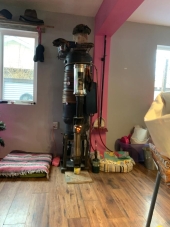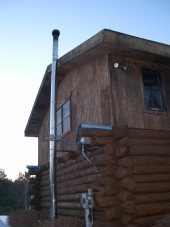We consulted on a design similar to what you suggest. It was not intended to replace a whole house furnace, but as supplemental heat for a ground-source heat pump. We've had a number of other basement inquiries lately. So I feel like reiterating the basics of basement heater design problems.
Several cautions with regard to a project like this:
1) Rocket mass heaters are designed as a radiant heater (for heating in direct contact and line-of site, normally 1 to 3 rooms unless the house is optimally designed for convection). They are not a furnace or boiler, the common devices used to burn in one place to deliver heat to another place. So unless you use the basement as living space, your benefit from the rocket mass heater would be greatly reduced. You will not see the efficiency levels with a furnace/forced air redesign, as you would with a house and heater that are optimally configured to deliver direct warmth where it's most needed. Air has a WAAAAY lower heat capacity than masonry; forced air tends to cool the occupants and increases your heating loads by requiring the home to be about 10 degrees warmer than if radiant heat is used (e.g. radiant floor heat). 10 degrees F can add 20% to your heating bill, more in some areas. Air ventilation is also essential for breathing health - if your main source of warmth for the upper rooms is warm air, and the house is ventilating properly at about 1/3 of its volume per hour (or more), you will be re-heating that volume of air at least every 3 hours. Expensive.
So if it's possible to heat built-in furniture right in the living spaces and get comforting warmth by direct conduction, you will enjoy much greater comfort at much lower fuel costs.
This is one reason why outdoor wood boilers take so much fuel - a lot of the heat is lost to the outdoors on its way to the house, and what's left is transferred several times, losing efficiency with each transfer.
2) Rocket mass heaters take supervision, unlike a furnace that's designed to operate itself with electrical controls in some hidden corner.
I only encourage basement designs when there is already a pattern of regular basement occupation: a place where you can comfortably spend time doing your normal daily activities while supervising the heater while it burns. For a whole multi-story house you might be looking at 6 or 8 hours of burning per day. If you have a home office or rec room where you spend hours every evening watching movies or doing jigsaw puzzles in the basement, you might not feel that these hours were a strain. If you have to set a timer and check the heater every hour as an interruption to daily activities, or risk coming down to find smoke leaking out around a jammed log, you will quickly come to resent the chore.
Our biggest whole-home heater that we have good all-year data on has convection channels and is supervised by its residents for about 8 hours per day; it heats 3000-5000 square feet in a mild climate. They dropped from 8 cords of wood (two woodstoves and a fireplace insert) to about 2 cords per year (still have both woodstoves in the wings, but primarily use the rocket mass heater for main floor and upper story heating). They don't use their forced air system at all because of horrible mold problems (coastal climate).
So it can be done, but you need to like fire. Their heater has pride of place in the main living room; it's where everyone sits with laptops, entertains guests, watches the kids play in the backyard. Easy to keep the fire going - you get up that often for a cup of tea or a bathroom break, if you follow ergonomic recommendations. Their three year old son was already learning to feed the fire - not always appropriately - but with dedication. A big safety factor in operating a wood-burning system without electrical controls is that old adage you see on every candle wrapper: never let a fire burn unattended. Good tending will improve the efficiency of almost any fire.
3) If you hide the heater in a dark corner where you don't like using it, you will tend not to run the fire as often as might be optimal. That in turn can exacerbate a problem with basement woodburning devices in general: cold starts. A cold chimney (colder than outside air, or just colder than the main house) tends to draw backwards - incoming air flows down the chimney. It's much harder to light a stove or heater when the chimney is operating backwards. Basements tend to be the coldest part of the house, so basement fireplaces and woodstoves are notoriously prone to smoky smells and backwards draft. The rocket mass heater is typically a low-draft system (less hot air leaves the building through the chimney), so it will suffer even worse if the situation involves cold starts and potential for backdrafts. Unless you are committed to operating the heater regularly throughout the heating season, the cold start problem can become a massive inconvenience and even a safety issue due to indoor smoke. There are design workarounds, like a bypass or chimney primer, but they sacrifice some efficiency in order to heat up the chimney faster.
A frequently-run heater in a basement that's kept well above the outdoor temperatures, and with good chimney height and balancing of the house's makeup air so there aren't negative pressure problems: it could work out great. The basement does offer great potential for passive convection of warm air to the rest of the house. And of course you could tap into existing forced-air ducting and fans if you design it carefully.
4) If you are accustomed to the level of electronic controls on a commercial boiler or furnace, you may be tempted to overpower any smoke-back problems with electrically powered fans. You're back to square one with the dependence on grid power, in that case. Also, these forced controls can cause the fire to burn dirtier, creating creosote deposits in the chimney and heating channels, or over-drafting during startup and making the kindling very hard to light.
We encourage sticking with a well-calibrated, solid-state, passive convection system if at all possible, for safety and successful operation during winter storms. A manual bypass valve, or a chimney priming hole, are about the level of cold-start controls we like to see in a primary heater. You can always use fans to move warm air around the building, balancing heat between rooms - in a winter storm survival situation, you just move yourself to the warm rooms while you wait for the fans to come back on.
For anyone considering a basement installation, I recommend asking yourself a few questions:
1) Do I really want to spend that much time in my basement in order to stay warm? Or would I rather spend my home time in a different part of the house?
2) How hard would it be to build up a masonry foundation from the basement level, have somebody re-frame the wood flooring around it, and install the heater with central pride of place where it can do the most good? Would it be worth it to replace that hide-a-bed with a full-body heated sofa / guest bed?
3) Is there another location that might be closer to the important parts of the house, where I could pour a concrete pad for a cheap foundation? Sometimes a garage that backs onto the living space can become the new, heated rec room, with no foundation work required and much easier chimney installation.
4) Am I willing to take the time, make design compromises, and modify based on test-firing or first-season experience, to make the heater work as I envision it? Am I willing to hire an engineer or team of experts to calibrate the design for me so it works the first time?
I am confident it can be done. But I only know of one built example so far, and that one has an electronic starter fan that has to be frequently replaced due to corrosive exhaust.
I have seen successful solid-state (no fans) mass heaters in 3-story houses, with very reasonable chimney priming required only at the beginning of the heating season. So there's no reason a 2-story house with basement couldn't be designed properly.
The best test cases will be in a home where the dry basement (which you have) or daylight basement is a major entertainment location for long winter evenings.
A suggestion if you haven't had any first-hand experience with these heaters at all: Maybe get one of the cheaper plans, or use someone else's successful project as a model, and do a mockup in your greenhouse or workshop first. Once you have some practice operating one in a 1-story building, you'll have a much better idea whether you want to have one in the main house. You won't spend so much on chimney fittings that way, and you can re-use most of the materials from the mockup if you want to just move the whole thing downstairs piece by piece. (in that case, I'd get one of the 8" plans, or enlarge a 6" plan to 8" components and scale everything up accordingly.)
Good luck, and please let us know how it goes. Happy to consult privately on a custom design if you want to buy some of our time.
Yours,
Erica Wisner
questions@ernieanderica.info




 2
2








 2
2












